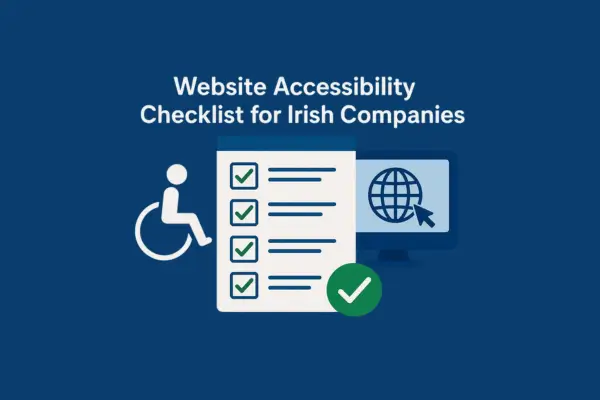WCAG (Web Content Accessibility Guidelines)
WCAG 2.1 and 2.2 define international best practices for accessibility. Most companies aim for Level AA compliance, which covers most real-world accessibility needs.
Published on Oct 10, 2025

Updatated on Oct 10, 2025
When I talk to business owners across Ireland, one question comes up again and again: “Do I really need to worry about website accessibility?” The short answer is yes — accessibility isn’t just about legal compliance; it’s about creating a website that works for everyone. It improves usability, SEO, and your brand reputation. In this guide, we’ll walk through a practical accessibility checklist tailored for Irish SMEs. You’ll get easy examples, best practices, and direct links to helpful Web Wizard resources. If you’d like a quick introduction first, have a look at our post What Is Web Accessibility? A Simple Guide Using HTML Attributes . It explains basic HTML accessibility features like Accessibility means that your website can be used by people with disabilities — visual, auditory, motor, or cognitive — and by those using assistive technologies such as screen readers or voice commands. But even beyond that, accessibility helps everyone, including people using mobiles, older devices, or slower internet connections. WCAG 2.1 and 2.2 define international best practices for accessibility. Most companies aim for Level AA compliance, which covers most real-world accessibility needs. ARIA attributes such as Using proper HTML tags like Here’s a practical checklist to follow for your Irish business website. You don’t need to do everything at once — even small improvements make a big difference. Accessibility improvements help Google understand your site better. For instance, using descriptive In our blog post Top 10 Mistakes to Avoid When Building a Business Website, we discussed how ignoring mobile design or slow site speed affects user experience. Those same mistakes can also hurt accessibility and rankings. Some small businesses in Ireland struggle to balance design, cost, and accessibility. But most improvements — like fixing heading order, labels, and colour contrast — are inexpensive and yield quick wins. Outdated themes or plugins may require upgrades, but it’s worth it for compliance and usability. Let’s imagine a Dublin-based company called GreenLeaf Eco Tours. They found that customers using mobile screen readers couldn’t use their booking form. By adding visible labels, descriptive alt text for tour images, and ensuring the booking button was keyboard accessible, their site became much easier to use. Accessibility also helped them appear higher in local search results. Accessibility isn’t just another technical task — it’s part of good design. For Irish companies looking to build trust and reach more people, making your website accessible is one of the best investments you can make. It shows you care, it helps your SEO, and it improves everyone’s experience on your site. If you’d like professional help, our team at Web Wizard can review and improve your site’s accessibility. We build websites that are beautiful, inclusive, and optimised for performance. Ready to make your website accessible? Contact Web Wizard today for a complete accessibility audit and improvement plan.alt text and ARIA labels in simple language.Why Website Accessibility Matters for Irish Businesses
Key Accessibility Standards to Understand
WCAG (Web Content Accessibility Guidelines)
ARIA (Accessible Rich Internet Applications)
aria-label, aria-hidden, and aria-describedby make interactive or dynamic elements (like dropdowns or modals) understandable to assistive tools.Semantic HTML and Landmarks
<header>, <nav>, <main>, and <footer> helps both screen readers and Google understand your content hierarchy.Website Accessibility Checklist for Irish Companies
1. Page Structure and Headings
h1 for main title, h2 for major sections, and so on. Avoid skipping levels.<header>, <nav>, <main>, and <footer>.<nav aria-label="Main navigation">
<ul>
<li><a href="/services">Services</a></li>
<li><a href="/blog">Blog</a></li>
</ul>
</nav>
2. Text and Readability
3. Images and Media
alt text for all meaningful images.alt="" (empty) for decorative images to skip them in screen readers.4. Keyboard Navigation and Focus
aria-expanded and aria-hidden for dropdowns and modals.<button aria-expanded="false" aria-controls="menu">Menu</button>
<div id="menu" aria-hidden="true">Menu links here</div>
5. Forms and Inputs
for and id.<fieldset> and <legend> for groups of radio buttons or checkboxes.<label for="email">Email address</label>
<input id="email" type="email" aria-describedby="emailHelp">
<span id="emailHelp">We’ll never share your email with anyone.</span>
6. Navigation and Menus
role="navigation" and aria-label for clarity.7. Dynamic and Interactive Content
aria-live for dynamically updated content.8. Colour and Contrast
9. Mobile Accessibility
10. Testing and Validation
Common Accessibility Issues in Irish Websites
for and id.aria-label attributes describing their function.Accessibility and SEO Go Hand in Hand
alt text for images helps both visually impaired users and search engines index your images.Printable Accessibility Summary
Area
Checkpoints
Structure
Headings order, skip links, landmarks
Text
Readable font, high contrast, scalable text
Images
Alt text, captions, transcripts
Forms
Labels, error messages, clear instructions
Navigation
Keyboard support, breadcrumbs, clear menus
Media
No auto-play, accessible controls
Colour
Contrast ratios, non-colour indicators
Testing
Screen reader, keyboard, Lighthouse checks
Rolling Out Accessibility on Your Website
Challenges for Irish Businesses
Fictional Example: GreenLeaf Eco Tours
Further Reading
Conclusion